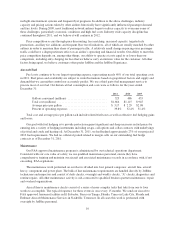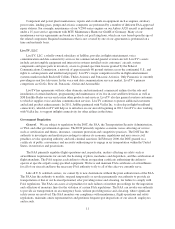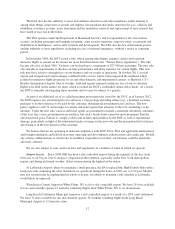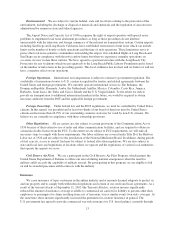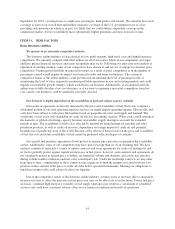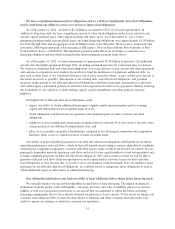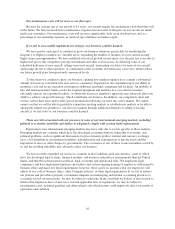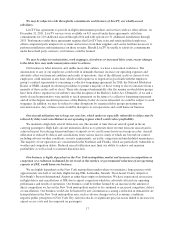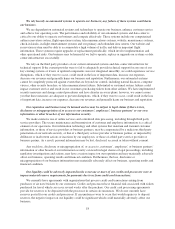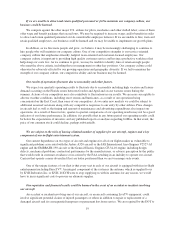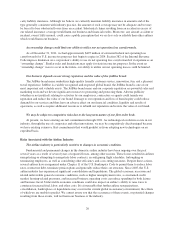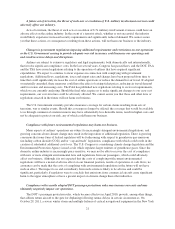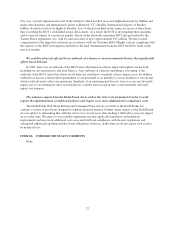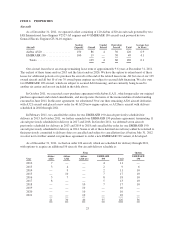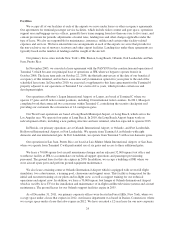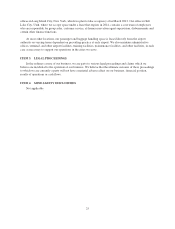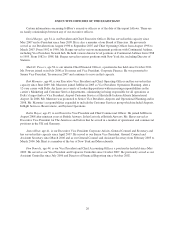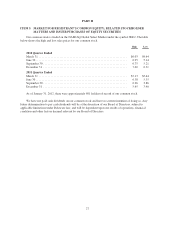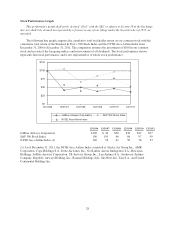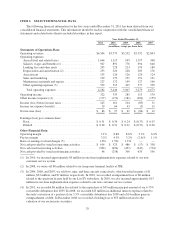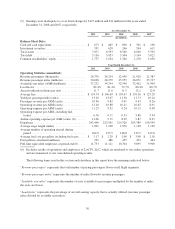JetBlue Airlines 2011 Annual Report Download - page 30
Download and view the complete annual report
Please find page 30 of the 2011 JetBlue Airlines annual report below. You can navigate through the pages in the report by either clicking on the pages listed below, or by using the keyword search tool below to find specific information within the annual report.carry liability insurance. Although we believe we currently maintain liability insurance in amounts and of the
type generally consistent with industry practice, the amount of such coverage may not be adequate and we may
be forced to bear substantial losses from an accident. Substantial claims resulting from an accident in excess of
our related insurance coverage would harm our business and financial results. Moreover, any aircraft accident or
incident, even if fully insured, could cause a public perception that we are less safe or reliable than other airlines
which would harm our business.
An ownership change could limit our ability to utilize our net operation loss carryforwards.
As of December 31, 2011, we had approximately $495 million of estimated federal net operating loss
carryforwards for U.S. income tax purposes that begin to expire in 2024. Section 382 of the Internal Revenue
Code imposes limitation on a corporation’s ability to use its net operating loss carryforwards if it experiences an
“ownership change”. Similar rules and limitations may apply for state income tax purposes. In the event an
“ownership change” were to occur in the future, our ability to utilize our net operating losses could be limited.
Our business depends on our strong reputation and the value of the JetBlue brand.
The JetBlue brand name symbolizes high-quality friendly customer service, innovation, fun, and a pleasant
travel experience. JetBlue is a widely recognized and respected global brand; the JetBlue brand is one of our
most important and valuable assets. The JetBlue brand name and our corporate reputation are powerful sales and
marketing tools and we devote significant resources to promoting and protecting them. Adverse publicity
(whether or not justified) relating to activities by our employees, contractors or agents could tarnish our
reputation and reduce the value of our brand. Damage to our reputation and loss of brand equity could reduce
demand for our services and thus have an adverse effect on our financial condition, liquidity and results of
operations, as well as require additional resources to rebuild our reputation and restore the value of our brand.
We may be subject to competitive risks due to the long term nature of our fleet order book.
At present, we have existing aircraft commitments through 2021. As technological evolution occurs in our
industry, through the use of composites and other innovations, we may be competitively disadvantaged because
we have existing extensive fleet commitments that would prohibit us from adopting new technologies on an
expedited basis.
Risks Associated with the Airline Industry
The airline industry is particularly sensitive to changes in economic condition.
Fundamental and permanent changes in the domestic airline industry have been ongoing over the past
several years as a result of several years of repeated losses, among other reasons. These losses resulted in airlines
renegotiating or attempting to renegotiate labor contracts, reconfiguring flight schedules, furloughing or
terminating employees, as well as considering other efficiency and cost-cutting measures. Despite these actions,
several airlines have reorganized under Chapter 11 of the U.S. Bankruptcy Code to permit them to reduce labor
rates, restructure debt, terminate pension plans and generally reduce their cost structure. Since 2005, the U.S.
airline industry has experienced significant consolidation and liquidations. The global economic recession and
related unfavorable general economic conditions, such as higher unemployment rates, a constrained credit
market, housing-related pressures, and increased business operating costs can reduce spending for both leisure
and business travel. Unfavorable economic conditions could also impact an airline’s ability to raise fares to
counteract increased fuel, labor, and other costs. It is foreseeable that further airline reorganizations,
consolidation, bankruptcies or liquidations may occur in the current global recessionary environment, the effects
of which we are unable to predict. We cannot assure you that the occurrence of these events, or potential changes
resulting from these events, will not harm our business or the industry.
20


